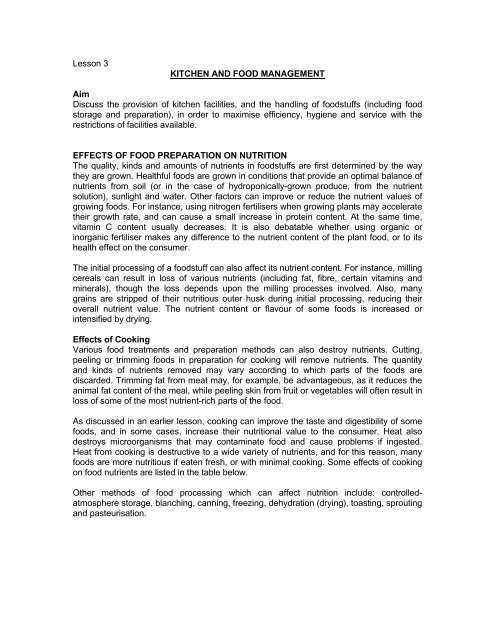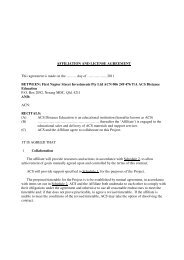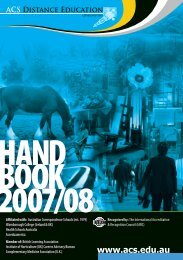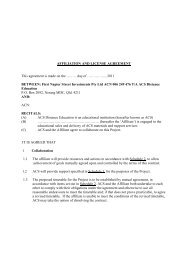Lesson 3 KITCHEN AND FOOD MANAGEMENT Aim Discuss the ...
Lesson 3 KITCHEN AND FOOD MANAGEMENT Aim Discuss the ...
Lesson 3 KITCHEN AND FOOD MANAGEMENT Aim Discuss the ...
- No tags were found...
You also want an ePaper? Increase the reach of your titles
YUMPU automatically turns print PDFs into web optimized ePapers that Google loves.
<strong>Lesson</strong> 3<strong>KITCHEN</strong> <strong>AND</strong> <strong>FOOD</strong> <strong>MANAGEMENT</strong><strong>Aim</strong><strong>Discuss</strong> <strong>the</strong> provision of kitchen facilities, and <strong>the</strong> handling of foodstuffs (including foodstorage and preparation), in order to maximise efficiency, hygiene and service with <strong>the</strong>restrictions of facilities available.EFFECTS OF <strong>FOOD</strong> PREPARATION ON NUTRITIONThe quality, kinds and amounts of nutrients in foodstuffs are first determined by <strong>the</strong> way<strong>the</strong>y are grown. Healthful foods are grown in conditions that provide an optimal balance ofnutrients from soil (or in <strong>the</strong> case of hydroponically-grown produce, from <strong>the</strong> nutrientsolution), sunlight and water. O<strong>the</strong>r factors can improve or reduce <strong>the</strong> nutrient values ofgrowing foods. For instance, using nitrogen fertilisers when growing plants may accelerate<strong>the</strong>ir growth rate, and can cause a small increase in protein content. At <strong>the</strong> same time,vitamin C content usually decreases. It is also debatable whe<strong>the</strong>r using organic orinorganic fertiliser makes any difference to <strong>the</strong> nutrient content of <strong>the</strong> plant food, or to itshealth effect on <strong>the</strong> consumer.The initial processing of a foodstuff can also affect its nutrient content. For instance, millingcereals can result in loss of various nutrients (including fat, fibre, certain vitamins andminerals), though <strong>the</strong> loss depends upon <strong>the</strong> milling processes involved. Also, manygrains are stripped of <strong>the</strong>ir nutritious outer husk during initial processing, reducing <strong>the</strong>iroverall nutrient value. The nutrient content or flavour of some foods is increased orintensified by drying.Effects of CookingVarious food treatments and preparation methods can also destroy nutrients. Cutting,peeling or trimming foods in preparation for cooking will remove nutrients. The quantityand kinds of nutrients removed may vary according to which parts of <strong>the</strong> foods arediscarded. Trimming fat from meat may, for example, be advantageous, as it reduces <strong>the</strong>animal fat content of <strong>the</strong> meal, while peeling skin from fruit or vegetables will often result inloss of some of <strong>the</strong> most nutrient-rich parts of <strong>the</strong> food.As discussed in an earlier lesson, cooking can improve <strong>the</strong> taste and digestibility of somefoods, and in some cases, increase <strong>the</strong>ir nutritional value to <strong>the</strong> consumer. Heat alsodestroys microorganisms that may contaminate food and cause problems if ingested.Heat from cooking is destructive to a wide variety of nutrients, and for this reason, manyfoods are more nutritious if eaten fresh, or with minimal cooking. Some effects of cookingon food nutrients are listed in <strong>the</strong> table below.O<strong>the</strong>r methods of food processing which can affect nutrition include: controlledatmospherestorage, blanching, canning, freezing, dehydration (drying), toasting, sproutingand pasteurisation.
• Laws require specified information be printed on labels attached to specified types offoods• Laws control <strong>the</strong> addition of additives to foods, including preservatives, colourings andflavour enhancers.• Laws control <strong>the</strong> storage and preparation of foods in commercial situations, includingshops, warehouses and restaurants.LabellingUsually a label must include:• A common name for <strong>the</strong> food• Name and address of <strong>the</strong> supplier or packer• No statement or pictures that are false or misleading.Labelling may state ingredients, but should contain no statement relating to medicalcondition (eg. It should not claim to be beneficial to a particular medical condition. Thiswould make it a medicine, ra<strong>the</strong>r than a food).Ingredients - When ingredients are stated, ALL ingredients must be stated, and listed indescending order of quantity (ie. The greatest quantity ingredients always listed first, and<strong>the</strong> least quantity listed last). Water can be simply stated as "water added", without anystatement of quantity. Some o<strong>the</strong>r foods (eg. cheese and alcohol) are exempted fromlistings of ingredients.NutrientsListing nutrients is normally required when nutrients are added to food, or when anutritional claim is made. Never<strong>the</strong>less, many manufacturers still include nutrients on alabel, even when not required by law.Nutrition labelling format is set down by law, requiring <strong>the</strong> label to include:• Serving size• Number of serves per pack• Energy (ie. kilojoules or cals)• Protein level• Fat level• Carbohydrate level• Sodium level• Potassium levelIf fortified with vitamins or minerals, <strong>the</strong> amounts of each of <strong>the</strong>se different nutrients mustbe included, toge<strong>the</strong>r with a statement of <strong>the</strong> proportion of <strong>the</strong> daily allowance in a statedamount of that food.DatingThis refers to a date marked on <strong>the</strong> food or package. This may be ei<strong>the</strong>r:• Date of packing or processing• Use by date (When it should be used by)• Best before date (When it is best to be used by).
Special Purpose FoodsSome foods may be designated as having a special purpose (eg. Approved by <strong>the</strong> heartfoundation, Low Joule food, Carbohydrate modified, etc). There are requirements thatmust be met to satisfy some of <strong>the</strong>se labellings.(Reference: Briggs and Wahlqvist (1988) Food Facts Penguin Books Australia)ETHICSThe Ethics of Using Food AdditivesIn many developed nations most people are part of large urban communities, where livingstandards are high. As consumer demands become more sophisticated, <strong>the</strong> amount offood additives used must increase.A Joint Committee of <strong>the</strong> Food and Agriculture Organisation (FAO) and <strong>the</strong> World HealthOrganisation (WHO) considered this problem and came to <strong>the</strong> conclusion that <strong>the</strong> use ofadditives was justified where <strong>the</strong>y fulfilled one or more of <strong>the</strong> following functions:• Maintaining nutritional quality of food• Enhancing keeping quality or stability with a reduction of food wastage• Making food more attractive to <strong>the</strong> consumer in a manner that does not lead todeception• Providing essential aids to processing.The control of additives in food is being gradually improved and tightened and testingprocedures are becoming more rigorous. In many developed nations, matters relating to<strong>the</strong> composition, description, labelling and advertising of food are considered by FoodStandards Groups; for example, in Britain, this is carried out by <strong>the</strong> Food StandardsCommittee.ALLERGIES, SENSITIVITY <strong>AND</strong> POISONINGAll foods are comprised of chemicals. The bulk of most foods will usually be well-known,safe chemical compounds, from <strong>the</strong> major food groups (ie. Any combination ofcarbohydrates, fats, proteins, minerals, vitamins, water).O<strong>the</strong>r components in foods, usually found in relatively small quantities, may include:• Alcohol• Trace Elements• Flavourings• Colourings• Additives (eg. preservatives)• Dietary fibre• Drugs (Pharmacologically active substances such as caffeine)• Toxins (eg. natural poisons such as cyanide)• Toxic Contaminants (eg. pesticides)• Non Toxic Contaminants.
Ano<strong>the</strong>r common consideration is <strong>the</strong> speed of development necessary for opening acommercial undertaking. If we give insufficient time to kitchen planning, staff may have tolive with <strong>the</strong> management’s mistakes; thus, long-term costs and expensive modificationsmay occur. Apart from <strong>the</strong> financial viewpoint, we must also consider <strong>the</strong> humanconsiderations of a working environment. If staff are satisfied and are working in acomfortable environment, <strong>the</strong>y are likely to be more efficient and productive. Good designshould result in higher productivity, faster service, more economical working, and most ofall, a better quality end product.Designers should also be concerned with hygiene, installation, maintenance and operatingcosts. The major factors to consider when designing a catering system are:• The products, <strong>the</strong> preparation and service of food and drink items• The volume of demand per service and <strong>the</strong> duration of service• The staff and support services required.The marketing policy or menu plan, and <strong>the</strong> purchasing policy (ie. types of food required tosatisfy <strong>the</strong> menu, i.e., fresh, frozen, dried, etc) will determine <strong>the</strong> catering design.EQUIPMENT DESIGNWe can subdivide equipment in <strong>the</strong> food area into <strong>the</strong> following groups:• Reception equipment - Items such as floor scales and trolleys• Storage equipment - Store room items and refrigerators• Preparation equipment - Equipment for removing packing, peeling and skinning, sizereduction, mixing and blending• Cooking equipment - Equipment designed to apply conduction and/or convectionand/or radiation to foods• Service equipment - Storage for end products, and for presentation• Cleaning equipment - Washing up, cleaning floors, cleaning o<strong>the</strong>r surfaces, and o<strong>the</strong>requipment.Criteria for Equipment SelectionThe selection, operating, location and maintenance of each item of equipment from any of<strong>the</strong> above groups should conform to certain criteria. For each item, consider <strong>the</strong> following:1. Original and Replacement CostsPlanners need this information to calculate <strong>the</strong> operational cost per hour for each item ofequipment. This is normally part of <strong>the</strong> annual depreciation allowance, based on <strong>the</strong>replacement cost less scrap value as opposed to <strong>the</strong> original cost.2. Expected LifeThe life of an item may need to be estimated because manufacturers are not alwaysspecific. The life will be affected by <strong>the</strong> way in which equipment is used. Equipment maybe subject to constant or only occasional use, and it may be used by only one operator orby many different operators. The methods of construction can also affect <strong>the</strong> life; forexample, a cast iron frame item may last longer than an item that is simply thin metalsheets bolted toge<strong>the</strong>r.
3. Capacity or SizeCapacity and size are measured in different ways for different pieces of equipment (ie. incubic meters for an oven or in litres of surface area for a mixer). Determine <strong>the</strong> actualuseable capacity or space ra<strong>the</strong>r than <strong>the</strong> gross figure, as certain areas - like tops andbottoms of conventional ovens, and <strong>the</strong> top 5 centimetres of a mixing bowl - may not beuseable in practice.4. Energy ConsumptionSaving energy is a common need, especially in high consumption areas such as catering.Fuels vary in cost, efficiency, and availability and <strong>the</strong> caterer must use energy properly. Heor she should cost equipment for energy consumption, both on stand-by, if applicable, andgive a rate per hour of operation.5. Maintenance ProgramManufacturers will advise on recommended maintenance programmes for <strong>the</strong>irequipment. Sometimes <strong>the</strong>y also offer a variety of maintenance contracts.Do not ignore or delay maintenance until equipment breaks down, as this can result intotal disruption of catering. Plan maintenance with on-site engineers. If <strong>the</strong> establishmentdoes not employ engineers, use a contractor for <strong>the</strong> maintenance. Ensure <strong>the</strong>maintenance is completed and registered in an inventory. This not only ensures that <strong>the</strong>work is done when it should be, but also provides records upon which to base costings.6. Cleaning ScheduleThe cleaning, whe<strong>the</strong>r daily, weekly or at o<strong>the</strong>r intervals, should be recorded and checkedon completion. The ease of cleaning and <strong>the</strong> method employed are important criterion thatmust be considered at <strong>the</strong> time of purchase. Avoid equipment with cracks between <strong>the</strong>surfaces, or with difficult access to parts that require cleaning.7. Specific PurposeSeveral items of equipment may be used for more than one purpose: for example, amixer/blender that has a comprehensive range of attachments. Defining <strong>the</strong> purpose ofany item of equipment with great care is very important, because only in such a way canaccurate decisions be made.8. Location or Degree of MobilityA degree of mobility may enable better use of some items of equipment. Systems now usemobile units with flexible power and service couplings so that ovens, for example, can bemoved easily from one section of <strong>the</strong> production area to ano<strong>the</strong>r9. SafetyIn most developed countries, legislation governs <strong>the</strong> manufacture and operation of manyitems of equipment.Equipment InventoryRecording information in an inventory system will enable accurate pricing in cost of capital,maintenance and energy per unit of production. To produce an equipment inventory, lookin more detail at <strong>the</strong> equipment used in <strong>the</strong> areas discussed in <strong>the</strong> following section. It isnecessary to identify <strong>the</strong> equipment normally found in <strong>the</strong>se areas, and how this affects<strong>the</strong> subsequent planning processes.
• Reception AreaAllow sufficient space for <strong>the</strong> receiving and checking of goods coming into and out of acatering area. (This may include a weighing machine). Provide a separate area for wastebins, empty containers, recycling bins etc. These might be mounted <strong>the</strong>se on a low standor rollers to simplify washing floors. Provide a separate room for refuse and waste in largerkitchens. This room should have a tiled floor and a central drain to allow lower walls and<strong>the</strong> floor to be washed down daily. Consider <strong>the</strong> refrigeration of this room, especially inwarmer climates. If bulky items such as cases and sacks are to be handled, makeprovision for trolleys and trolley parking areas.• Storage AreaDesign <strong>the</strong> stores area in any catering establishment in a way that helps <strong>the</strong> successfulrunning of <strong>the</strong> kitchen. The main object is to keep reasonable stocks so that <strong>the</strong> kitchencan supply a meal whenever one is required. If you have not allowed sufficient storagespace, you might need to purchase food more often and perhaps in a hurry. If anexcessively large space is allocated to stores, <strong>the</strong>re can be a danger of overbuying/overstocking, so that food might not be as fresh as it should have been.Before deciding what storage space is needed, consider <strong>the</strong> delivery position. If deliveriesare made daily, you can reduce <strong>the</strong> amount of storage; if <strong>the</strong>re is a minimum sized orderrequired for delivery, <strong>the</strong> store must cater to that size. For establishments in isolatedareas, deliveries may be less frequent, so a larger store with special facilities (eg. coolrooms etc) may be needed to hold larger amounts of foodstuffs.Storerooms should have appropriate ventilation and insulation. This may be helped bywhere <strong>the</strong>y are located within a building. Consider prevailing wea<strong>the</strong>r (eg. direct sun,prevailing winds etc).Storage areas may be divided into <strong>the</strong> following areas:ooDry StoreGenerally <strong>the</strong> temperature of a dry store should be approximately 9 to 10 degreesCelsius. This may be achieved through natural ventilation and insulation or, insome instances, with <strong>the</strong> aid of gentle refrigeration. Fittings are best made of noncorrosivemetal (eg. stainless steel), if possible, ra<strong>the</strong>r than with timber shelving orbenches. Metal storage bins are preferable for sugar, flour and dry cereals. Mount<strong>the</strong>se bins on wheels or suitable castors so <strong>the</strong>y can be easily moved in and out offood preparation areas, if necessary. Fit <strong>the</strong> storeroom with both platform and tableweighing machines. Shelves under tabletops should be a minimum of at least230mm above <strong>the</strong> floor, to make cleaning easier.Vegetable StoreThe temperature should be around 9 degrees Celsius or lower. This room needsmore detailed attention than o<strong>the</strong>r storerooms because of <strong>the</strong> possible rapiddeterioration of this type of food. Provide sufficient raised platform space,preferably slatted metal storage, for sacks of potatoes and o<strong>the</strong>r root vegetables.This creates circulation of air, which prevents <strong>the</strong> moisture that causes moulds orrots. Provide open-mesh storage racks or bins for o<strong>the</strong>r vegetables. These shouldbe shallow for <strong>the</strong> storage of green vegetables (in single layers).
Fit <strong>the</strong> bottom of each rack or bin with a tray to collect dust or o<strong>the</strong>r rubbish (mount<strong>the</strong>se collection trays at least 230mm above <strong>the</strong> floor for ease of cleaning).oRefrigeration StoresYou cannot store all different types of foods in a normal refrigerated room. Amongo<strong>the</strong>r reasons, some foods (eg. fish) have strong odours that can taint <strong>the</strong> flavourof o<strong>the</strong>r foods. Authorities usually recommend that special fish storage cabinetsoperate at 0 o C. High humidity is also preferable for storing wet fish or fish fillets.Larger establishments require separate meat daily, and can divide general andcold stores, and total this up through <strong>the</strong> o<strong>the</strong>r rooms. A useful guide for estimating<strong>the</strong> capacities is 3.4 cu. metres per ton of meat; 4.25 cubic metres per ton of wetfish; and 7.1 cu. metres per ton of mixed daily produce.Storage TemperaturesDeep FreezeGeneral Cold RoomFresh MeatFrozen MeatWet FishMilk and dairy produce-18 o C+ 4 o C- 1 o C- 8 o C0 o C+ 4 o CDeep freeze storage may ei<strong>the</strong>r be a cabinet model with swing doors, or a lift up lid (chest)type. Both are equally effective. In larger establishments, an actual deep freeze roommight be necessary for frozen foods, ice cream, etc. Besides a refrigerator and deepfreeze, an ice-making unit may also be needed. The capacity for ice making will dependupon both <strong>the</strong> establishment size and <strong>the</strong> climate. Alternatively, if iced drinks are servedfrom <strong>the</strong> kitchen, installing a separate ice cube (or flake) maker may be necessary.Managing <strong>the</strong> FreezerYou should plan what you freeze. Keep a written record of what you freeze and when youfreeze it, so you can identify <strong>the</strong> oldest food, which should be used first. When you removesomething from <strong>the</strong> freezer, mark it off on your record. Plan how much of each crop youput into <strong>the</strong> freezer, so you don't end up with too much of one thing and too little ofano<strong>the</strong>r.Consider:• The size of your freezer• How much food you need• Seasonal variations in supply and quality of produce, and whe<strong>the</strong>r or not largequantities will be frozen• The time needed to prepare and pack food for freezing.
PREPARATION AREASAll stages of <strong>the</strong> preparation operations are very important to correct planning, and oneshould study <strong>the</strong>m carefully. These activities offer many opportunities for savings in time.Having separate rooms for various preparations is not necessary, especially in a smalleroperation. Staff can carry out work adequately on special tables within <strong>the</strong> perimeter of <strong>the</strong>kitchen area, if <strong>the</strong>re is sufficient demarcation such as an above-bench division, orpreferably a low wall division. The following notes refer to different preparation areas orrooms.Vegetable PreparationBecause many vegetables are bulky, provide deep sinks in <strong>the</strong> preparation area. Theseshould be duel sinks: one compartment for soaking before trimming, and <strong>the</strong> second forsoaking before cooking. In <strong>the</strong> larger kitchens, make <strong>the</strong> preparation and soak sinksmobile. After washing, peeling etc, <strong>the</strong> water drains into an open gully and cooks transport<strong>the</strong> semi-dry raw vegetables from <strong>the</strong> sinks to <strong>the</strong> appropriate cooking appliances. Thissaves double handling of raw materials.The preparation tables should be constructed of metal, but hand slicing requires portablewooden blocks. Allow sufficient storage for preparation utensils, such as knives, etc. Haveopen-mesh racks underneath <strong>the</strong> preparation bench to store utensils. Machinery shouldinclude a peeler, chipper, and a general-purpose machine for size reduction. There aremany needs for size reduction equipment such as dicers, shredders, slicers, graters, etc.in <strong>the</strong> preparation areas, so maintain a central pool of this equipment in largerestablishments.Salad PreparationIn smaller catering establishments, carry this work out in <strong>the</strong> vegetable room or area. Inlarger kitchens, and where salads are served in large quantities, make this room separate.It should be next to <strong>the</strong> cold rooms, and fitted with stainless steel bench, with removablewooden chopping benches. Have sufficient bench area to set out <strong>the</strong> salads afterpreparation. Larger establishments should be fitted with a small cold cabinet for salads,cold meats, hors d'oeuvres, etc.Meat PreparationBecause of transportation of bulk meat from <strong>the</strong> cold room, have <strong>the</strong> preparation area asclose as possible to <strong>the</strong> cold storage. The larger catering establishments might need to befitted with virtually a complete butcher’s shop, because meat carcasses have to be cut upand prepared, and joints minced, etc. for pies and o<strong>the</strong>r dishes. Poultry and game requiresimilar facilities. Fit this room with a large chopping block, hanging racks, plenty ofstainless steel bench space with portable wood carving blocks, and draws underneath tostore cutting knives. The benches should have a stainless steel sink let into <strong>the</strong> top.In <strong>the</strong> very large catering establishments, one can fit overhead tracks and pulleys from <strong>the</strong>cold store to <strong>the</strong> preparation area to help <strong>the</strong> handling of large pieces of meat. Amechanical saw is useful for cutting <strong>the</strong> larger pieces of meat. The smaller cateringestablishment may not need a meat-mincing machine, normally an attachment to <strong>the</strong>general-purpose mixing machine in <strong>the</strong> kitchen. In larger establishments, however, amincing machine is essential. Kitchens will require various o<strong>the</strong>r machines like a sausagemachine, steak tenderisers, gravity feed slicers, bowl cutters, etc.
Fish PreparationCooks can often carry this work out in <strong>the</strong> meat preparation area in smallerestablishments, if <strong>the</strong>y make a small division to isolate <strong>the</strong> work. The fish section shouldhave a bench with a slate or marble top for cutting, and a stainless steel sink. If possible, itis advisable to establish a separate fish preparation area. The sink must be large enoughto immerse fish for defrosting and any o<strong>the</strong>r preparation. As this type of preparation is wet,it is essential that <strong>the</strong> design of <strong>the</strong> preparation tables allows for cracks and crevices tocause seepage underneath. Do not have draws under <strong>the</strong> benches for knife storage. Store<strong>the</strong>se in a removable, lockable utensil box.Pastry PreparationThis area should be as close as possible to <strong>the</strong> cold store to simplify <strong>the</strong> handling of flourand <strong>the</strong> o<strong>the</strong>r goods used in this section. Some chefs, however, prefer to have <strong>the</strong> actualflour storage area in <strong>the</strong> pastry preparation room. A fur<strong>the</strong>r point to decide is whe<strong>the</strong>r thisarea will be simply for pastry preparation or will also include <strong>the</strong> bakery. Usually in smallerestablishments, this is a separate pastry preparation area only, because <strong>the</strong> cookingrange, or possibly a small pastry oven, would be in <strong>the</strong> kitchen along with <strong>the</strong> main batteryof equipment. In larger establishments, or where a lot of pastry is to be prepared, <strong>the</strong>pastry preparation room would be a bakery, where <strong>the</strong> oven is located.If a shortage of space does not allow for separate preparation areas, and pastrypreparation has to be done in <strong>the</strong> kitchen area, always do this work in <strong>the</strong> coolest part of<strong>the</strong> kitchen. Provide stainless steel benches with flush marble inserts in this area. Thestainless steel sinks should be fitted with sufficient drawers under <strong>the</strong> bench toaccommodate cutting and preparation utensils. If flour is stored in <strong>the</strong> pastry preparationroom, fit <strong>the</strong> storage bins with castors to make <strong>the</strong>m mobile. The equipment required willvary according to <strong>the</strong> requirements of <strong>the</strong> pastry or baked goods, but a mixing machine isessential, except in a very small kitchen when a general-purpose mixer can be used.O<strong>the</strong>r equipment includes a dough divider, moulder, pastry roller, small cold cabinet,boiling table, pie/tart machines, scales, cooling racks, proving ovens and stacking racks.COOKING AREAThis section describes some available cooking appliances and <strong>the</strong> capacities or outputsobtainable from <strong>the</strong>m, to help owners estimate individual cooking equipment requirements.Central RangeThis is <strong>the</strong> most important item in <strong>the</strong> kitchen, and in some smaller hotels and restaurantsit may be <strong>the</strong> only piece of cooking equipment installed. In larger kitchens, though, variouscooking processes on a cooking range will need to be broken down, and carried out onspecially designed equipment. The cooking range typically has ovens below for roasting,baking, etc. and hot plates above for boiling, simmering or frying purposes. Alternatively,<strong>the</strong> hot plates may be mounted separate to <strong>the</strong> oven. The height of both depends onpreference, and on space available.Capacities:OvensHot Plates0.03 cubic metres per 4.5 kg of meat10 square metres of hot plate will accommodate2.3 litres of pan space.
Convection OvensThese ovens have become increasingly popular because of <strong>the</strong>ir cooking speed, reducedcooking times, flexibility as a general purpose oven, evenness of cooking, uses as areheat oven for pre cooked frozen foods.Microwave OvensWhen first introduced, <strong>the</strong>se often produced poor results, such as bland-looking orunevenly heated food, or soggy ra<strong>the</strong>r than crisp textures; hence microwaves gained abad name with many caterers. These early microwave ovens, however, did have <strong>the</strong>unique ability to rapidly heat precooked food, or to rapidly defrost frozen portions, andquickly became standard features of many food establishments. Some modern microwaveovens have overcome previous problems and have many features that allow <strong>the</strong>m to beused for more than defrosting or heating. Still, many restaurants use microwaves only forlimited purposes, not for cooking meals, one reason being that <strong>the</strong> flavour, texture andhealthfulness of microwaved food are often believed to be inferior.O<strong>the</strong>r types of cooking equipment include:• pastry oven• boiling pans• bratt pan• deep fryers• steamers• fryers• grillers• infra red ovens.Cleaning AreaThe main concerns in this area are washing dishes and waste disposal. The wash up areashould be situated as close as possible to <strong>the</strong> service point, to reduce <strong>the</strong> movementinvolved in returning <strong>the</strong> crockery to <strong>the</strong> service areas, where <strong>the</strong> majority is stored andreused. Incorporate <strong>the</strong> following features in all wash up areas:• An adequate unloading area that can handle peak loads, with a separate area forglasses, silver and crockery• A pre-soak area convenient to <strong>the</strong> wash up area, for silverware or for casserole andegg dishes• Ample sorting and loading racks• A scrapping area. Remove leftovers from <strong>the</strong> plates before washing, and place in arefuse container in <strong>the</strong> receiving area. Smaller establishments could have a rubberringedhole in <strong>the</strong> receiving table with a refuse bin placed underneath, but largerkitchens should have a waste disposal unit mounted into <strong>the</strong> receiving table• A straight run out of <strong>the</strong> washing area, especially if <strong>the</strong> dishwasher is used. Thisshould be long enough to hold a minimum of three racks• A dish storing area. This will depend upon <strong>the</strong> layout and whe<strong>the</strong>r or not <strong>the</strong> dishes areto be stored on <strong>the</strong> outlet side of <strong>the</strong> washing area, or returned to <strong>the</strong> service area forimmediate re-use or storage. If <strong>the</strong> crockery is to be stored for any length of time,enclose <strong>the</strong> storage racks or cabinets.
• Open-type shelves must be perforated with wire mesh. These shelves should beincorporated underneath <strong>the</strong> tables for <strong>the</strong> accommodation of sterilised baskets, washupbaskets, etc.• Allow sufficient space underneath <strong>the</strong> dishwashing table to store scrap or waste bins. Ifwaste disposal units are not incorporated, <strong>the</strong>se bins should be mounted on wheels orcastors to simplify <strong>the</strong>ir removal to <strong>the</strong> refuse dispatch department. These featuresmay be modified if kitchens employ trolleys or conveyor return systems.The washing-up kitchen and general utensils must be in a separate area, as close aspossible to <strong>the</strong> actual cooking area, especially <strong>the</strong> cooking range where most utensils areused. A large stainless steel washing sink (approx 45cm deep) for pots and pans is ideal.A deep sterilising unit next to <strong>the</strong> sink is handy for brief immersion after washing. A metalstorage rack can be located next to <strong>the</strong> sterilising unit for storing pots and pans. All of thiswill ease <strong>the</strong> flow through <strong>the</strong> washing process. Depending upon <strong>the</strong> establishment,special arrangements may be made for hand washing facilities (a separate area),washing/sterilising sink, batch or flight dish washing, and separate arrangements forcutlery, silverware and glass.Waste DisposalOrganic waste produced in commercial catering may be disposed of through a food wastedisposer. Dependent on <strong>the</strong> temperature, organic waste breaks down rapidly throughdecomposition. The resultant offensive odours from this process are one of <strong>the</strong> reasons forpurchasing a food waste disposer. This type of disposer should not be used for solid wastesuch as plastic, bottles, wood, cardboard, paper, etc. If <strong>the</strong> food waste disposer is used, itcreates a problem because storage space has to be found.The installation of a compactor can cut down this area considerably, as by compression, itreduces <strong>the</strong> waste fed into it by between one fifth and one eighth of its original size. Thecompaction process usually takes place inside a plastic bag or cardboard carton, whichcan be sealed, both organic and inorganic waste can be placed in <strong>the</strong> same machine.The caterer who decides to purchase a food waste disposer has a wide choice ofmachines available to <strong>the</strong>m. Obviously with such a wide variation in power, <strong>the</strong> choice of<strong>the</strong> correct unit can be difficult. Most manufacturers <strong>the</strong>refore employ technical staff whocan advise on:• Whe<strong>the</strong>r <strong>the</strong> drainage allows for <strong>the</strong> installation of a food waste disposer• The best position to locate <strong>the</strong> unit• The approximate cost of installation.Use this service at an early stage because <strong>the</strong> user will <strong>the</strong>n know that <strong>the</strong>y havepurchased <strong>the</strong> correct machine for <strong>the</strong> job, and sited correctly. Any guide about <strong>the</strong>required power for a unit should only be approximate because much depends on <strong>the</strong>quantity and type of waste that needs to be disposed of.The two main waste producing areas in a catering establishment are <strong>the</strong> food preparationand plate clearing areas. Generally <strong>the</strong> type of waste produced in <strong>the</strong> clearing operation ismuch lighter than that in <strong>the</strong> food preparation area.
In smaller catering establishments, one food waste disposal unit will normally cover bothjobs, but it is important that <strong>the</strong> unit is geared to deal with <strong>the</strong> heavier or preparation waste,o<strong>the</strong>rwise <strong>the</strong> machine will become overloaded. The main direct commercial advantage ofa waste disposal unit is to save labour costs.<strong>FOOD</strong> SERVICEFood service is complementary to food preparation and cookery. The service machinery isclosely related. Thus, if <strong>the</strong> kitchen works on partie lines, <strong>the</strong>y similarly organise and divide<strong>the</strong> room into stations. The owner or headwaiter is in charge of <strong>the</strong> service. The seniorsupervisor, or food service manager, is usually in charge of all food service, and this mayinclude service in restaurants, in a lounge, a coffee shop, at a bar, and/or room service.Service EquipmentThe range of equipment available under this heading is very wide, and it is influenced by<strong>the</strong> method or methods of service chosen to meet <strong>the</strong> needs of <strong>the</strong> consumer. Serviceequipment includes <strong>the</strong> following items:• Bains marie - a utensil which keeps liquid at simmering point, used to keep foodswarm. Usually consists of a pan sitting in or over a larger pan filled with water.• Hot cupboards• Infra red lamps/heaters - an overhead heating system which keeps food warm withoutcooking it or allowing it to dry out quickly.• Refrigerated and/or heated display units - usually enclosed, to keep foodstuff ei<strong>the</strong>rcool or warm.• Counter units• Conveyor systems• Serving trays, crockery, cutlery, glass, linen etc.• Beverage preparation/service units.<strong>FOOD</strong> SERVICE <strong>MANAGEMENT</strong>The organisation of work in <strong>the</strong> kitchen will depend on <strong>the</strong> type and size of operation, and<strong>the</strong> ratio of semi skilled or unskilled to skilled workers being used (maybe 1:3).Mechanisation and <strong>the</strong> use of convenience foods have altered jobs in <strong>the</strong> kitchensignificantly, and shrinking profit margins require more efficient and profitable working. It is<strong>the</strong>refore very important to train and develop staff (succession planning) not only intechnical skills but also in supervisory and management skills.It is essential to control materials (now an increasing cost factor in receipt), storage,preparation, cooking and service, and <strong>the</strong> elimination of waste. Quality control is practicedon a more sophisticated basis, and standardised operational instructions call for precisemenu production to consistent standards.
<strong>MANAGEMENT</strong> <strong>AND</strong> SUPERVISIONThe task of management is to secure close cooperation between <strong>the</strong> food preparation and<strong>the</strong> service (eg. serving or waiting on customers). In a guesthouse or small restaurant, <strong>the</strong>owner is often in charge of service, and possibly someone else (eg. an employee orrelative) might handle <strong>the</strong> food preparation. In larger operations, both <strong>the</strong> cook and <strong>the</strong>waiter (or maitre de) are employees, perhaps on equal footing, and <strong>the</strong>re can be potentialfor conflict of opinions.The traditional staffing of a conventional kitchen follows <strong>the</strong> well-known partie or cornersystem. Kitchens organise <strong>the</strong> department into three sections: <strong>the</strong> larder, <strong>the</strong> kitchen,and <strong>the</strong> pantry, with certain ancillaries such as <strong>the</strong> stillroom, stores, wash up and plunge,all under <strong>the</strong> command of <strong>the</strong> head chefs office. In a larger establishment, such as aresort, <strong>the</strong> organisation might be as follows:Head Chef (OFFICE)Head ChefSous ChefSecretariesService AssistantsLarder Kitchen Pantry ServicesLarder (Partie) Sauce (Partie) Pastry (Partie) Still RoomFish (Partie)StoresRoast (Partie)Wash upTournants Vegetables (Partie) PlungeChef de Partie Soup (Partie)First Commis Grill (Partie)Commis Trainees Breakfast and Staff (Partie)This is a basic organisation for a traditional European/Western Catering Service.Variations are possible through <strong>the</strong> margin of functions according to <strong>the</strong> production output.In charge of each partie is a Chef de Partie, helped by a first, second and third Commisand trainees who act as Commis Cooks (also known as Tournants or relief cooks). Alsoincluded are a Chef de partie and Sous Chefs who are qualified as trainers.A central production unit might take <strong>the</strong> following form:Head Chef (OFFICE)Sous ChefSecretariesLarder Kitchen Pastry ServicesLarder (Partie) Soups/Sauces (Partie) Pastry (Partie) TransportStores Roasts (Partie) Bakehouse Wash upVegetables (Partie)Plunge
MENU <strong>AND</strong> PRODUCTION PLANNINGThis planning should be <strong>the</strong> result of a group decision by managers - not just <strong>the</strong> chef.One appreciates that <strong>the</strong> skilled chef, in designing his menu, takes into account previoussales figures, which reflect customer preferences. He needs to consider <strong>the</strong> menubalance, texture, flavour, taste, blend of different cooking methods, and (perhaps) <strong>the</strong> useof left overs. He will take account of his staff, and <strong>the</strong>ir ability to produce any standard orvariable menu using <strong>the</strong> equipment available.Methods of Kitchen ProductionForms of kitchen production can include:A La Carte ProductionThis can be defined as <strong>the</strong> traditional method of <strong>the</strong> conventional or partie system. Themenu offers a wide choice of dishes and prices. On <strong>the</strong> kitchen production side, a certainamount of mise en place or advance preparation is done for each service, for example,garnishes, sauces and <strong>the</strong> like. Apart from this, all dishes ordered sur la commande arecooked to order. This requires a flexible system in <strong>the</strong> kitchen, and relies upon <strong>the</strong> work ofskilled staff.Table d'Hote ProductionA set menu is easier to organise and produce in a kitchen. It consists of each section of<strong>the</strong> kitchen department producing a set number of portions of each course at each mealservice. The meal can <strong>the</strong>n be dished up and served from a hot plate as required. This is astraightforward service and it is one that can be geared to a personal waiter or waitressservice, or to various forms of self-service (eg. buffet). This system is less onerous than ala carte, and may not require such a high degree of skill from staff. It also allows generousportions to be produced at lower cost.Call-Order ProductionThis is <strong>the</strong> type of service used to provide room service meals in a hotel. It requires lessequipment than for an a la carte operation. The menu is normally restricted in size andscope, and is commonly made up of convenient, easy to prepare foods. Typical equipmentneeded might be refrigerators, grills, toasters, deep fryers, microwaves and convectionovens.There are also o<strong>the</strong>r systems such as a very sophisticated a la carte system (where nofood is pre-prepared), or a simpler system, where all food is served cold (eg. fruit, icecream, sandwiches, etc).DIVISION OF ACTIVITIES IN COOK- FREEZE OPERATIONPlan a cook-freeze operation to ensure a smooth workflow at each stage of processing,and also throughout <strong>the</strong> overall operation.The main activities are:• Storage of meat, vegetables, and dry storesThis is <strong>the</strong> same as in conventional operations.
• Preparation of CookingFood preparation is <strong>the</strong> same as for traditional methods, with <strong>the</strong> exception that forquantity, production methods are used. While cooking is similar to a traditional cateringsystem, less equipment (taking up less space) is needed. Production is programmed tocook large quantities, thus fully using large-scale equipment and economising on energy.• Pre-Packed for FreezingConsider <strong>the</strong> container size, making sure it is appropriate for handling. The partitioning isdetermined by freezing, transport and reheating requirements. Freezing efficiency is best if<strong>the</strong> depth or thickness of <strong>the</strong> food is no more than 25 to 38mm.• FreezingBlast freezing is <strong>the</strong> most suitable way of dealing with commercial catering-scale freezing.It is flexible, and can freeze all shapes of product. A very strict specification is needed for<strong>the</strong> specified amount of food to be frozen to a temperature of minus 20 o C. It is importantthat freezing is as rapid as possible to maintain flavour and texture after reheating. Theactual freezing rate varies according to <strong>the</strong> thickness, texture and characteristics of food.• SealingYou can store frozen food in reusable containers, or in poly<strong>the</strong>ne bags.• Deep Freeze Holding StoreIt is necessary to use a deep freeze holding store to ensure that <strong>the</strong>re is no deteriorationof product, and to control supply of food.• Reheating and ServiceReheating is done by dry heat, moist heat, or microwave heat. All are different. Traditionalcooking equipment can be used to reheat pre-cooked frozen foods. Specialisedequipment includes forced convection ovens, radiant heat and microwave ovens, and allgive different results.SELF ASSESSMENTPerform <strong>the</strong> self assessment test titled ‘Test 3.1’If you answer incorrectly, review <strong>the</strong> notes and try <strong>the</strong> test again.
SET TASK1. Obtain leaflets or information about different types of stoves and ovens. Compare <strong>the</strong>alternatives in terms of such factors as:• How easy <strong>the</strong>y are to clean• Durability (ie. can <strong>the</strong>y break)• Energy efficiency and cost of operation• Versatility (What range of cooking applications do <strong>the</strong>y have and how easy are <strong>the</strong>y touse)• Capacity (ie. Can <strong>the</strong>y cater for larger numbers of people quickly)• Cost (upfront and maintenance, parts etc).2. Visit a catering kitchen or restaurant kitchen and observe <strong>the</strong>ir staffing processes,operational processes and maintenance processes. Make notes based on yourobservations.ASSIGNMENTDownload and do <strong>the</strong> assignment called ‘<strong>Lesson</strong> 3 Assignment’.







